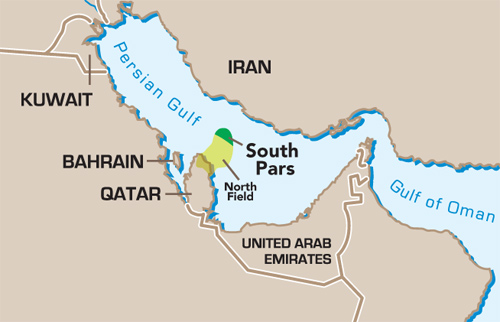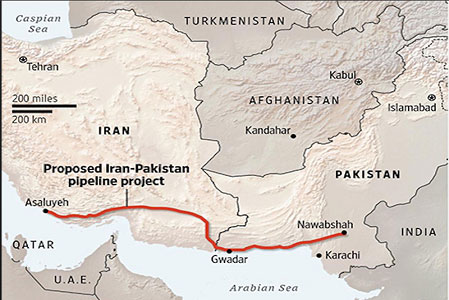Washington seeks to hit Iran's oil and gas sector as hard as possible, but it can also boomerang in its own one. Chinese companies can replace Europeans in Iran and get a new source of LNG, which will become a direct competitor to the American liquefied gas.
The French oil giant Total said it would withdraw from the Iranian project to develop the 11th stage of the giant South Pars gas field, unless the US renounces the right of sanctions against the company for cooperation with Tehran. In an official message released by Total, it is said that till November 4 the company should receive guarantees not to fall under all sanctions, including the new ones. The sanctions envisage banning companies co-operating with Iran to be financed by American banks in dollars, to have American shareholders and to operate in the United States. For the French company, this is unacceptable, since US banks are involved in 90% of Total operations, 30% of the company's shareholders are Americans, and its assets in the US exceed $ 10 billion.
The French company said they hope for the support of the French and European Union authorities. Emmanuel Macron, in turn, supported Brussels’ idea to protect and compensate losses of European companies from US sanctions. He stated this today in Bulgaria. However, this option is unlikely to suit Total.
Another matter is that there are those who are already willing to replace the French company in South Pars. "If this happens, the Chinese CNPC company will replace Total," the Iranian Shana news service quotes Iranian Oil Minister Bijan Namdar Zanganeh as saying. In turn, the Reuters news agency, citing a high-ranking official in the oil and gas industry of China, confirms the statement of the head of the Iranian energy department. The probability of Total quitting is quite high, and if this happens, then CNPC is ready to replace it, the source said.
Thus, the Chinese CNPC can become the owner of an 80% stake in the development project of the 11th stage of South Pars, which Iran shares in the Persian Gulf with Qatar and whose reserves are estimated at 51 trillion cubic meters of gas. Now the Chinese own 30%. Another 20% are located in the Iranian Petropars.

Earlier, in the first half of May, the National Iranian Gas Company (NIGS) said it plans to increase gas exports by 2021 by more than three times - to 200 million cubic meters. In theory, China, which, for example, had imported Iranian oil even during previous sanctions, could take advantage of the situation and create a new source of gas supplies in the medium term.
However, the development of South Pars is aimed, first of all, at meeting Iran's domestic needs and, as noted by Deputy Director of the National Energy Security Fund Alexey Grivach, pipeline exports to China from Iran are unlikely. Therefore, China would be interested in gas as LNG. "However, the question of further marketing of gas is arising. Make LNG without a Western partner will not succeed. Almost the only viable option for pipeline exports is India. Therefore, I would not rule out negotiations with Indian buyers," the expert concluded.
However, the option of supplying LNG to China cannot be ruled out, but from Pakistan. This is an unfinished gas pipeline from Iran to Pakistan and possibly to India (IP gas line project). Gazprom was going to participate in it, counting on shares in the Iranian deposits.
Iran has built its own part of the trunk with a capacity of 40 billion cubic meters, but Pakistan has not done anything under the pressure of the United States. However, in 2009 Tehran and Islamabad signed an agreement on gas supplies beginning 2015 and, in case of refusal Pakistan is obliged to pay a fine of $ 1 million for each day. In Islamabad, they announced their readiness to revive the construction of the pipeline after the announcement of the US withdrawal from the "nuclear deal" with Iran. The Pakistani The News reports that the Pakistani Prime Minister Shahid Khaqan Abbasi invited Iranian representatives to visit the country's capital in May and hold talks on the gas pipeline. This was reported to journalists by a senior official of the oil department of the Ministry of Energy of Pakistan. He added that both sides will discuss how to implement the project in the conditions of American sanctions.
Earlier, the Pakistani The Express Tribune reported that the new Prime Minister Shahid Khaqan Abbasi, who previously headed the ministry of energy, plans to revive an alternative version of the Iran-Pakistan gas pipeline across Pakistan. He assumes that the gas pipeline will be laid through the Gwadar Port, where the LNG terminal will be located. In 2015, China and Pakistan signed an intergovernmental agreement and 85% of the financing was taken by the Foreign Trade Bank of China. Last year, however, the previous Prime Minister Nawaz Sharif halted the project because of the pressure of Saudi Arabia, which believed that the infrastructure would be used to supply LNG from Qatar.

Deliveries of gas to Pakistan will fall under US sanctions, but in Tehran came up with a non-standard move. As Radio Liberty reports, in late April, the head of the National Oil Company, Hamid Reza Araki, said that Turkmenistan was offered swap gas supplies to Pakistan. On the one hand, such deals are not prohibited and Iran carried them out during the previous sanctions regime with Kazakhstan and Turkmenistan. On the other hand, Turkmenistan is experiencing an economic crisis, which was exacerbated by the fact that Ashgabat sharply raised the price of "blue fuel" and Gazprom suspended the contract for the purchase of gas, and Iran refused to pay new bills. Today Turkmenistan has a TAPI gas pipeline project through Afghanistan and Pakistan to India, but its implementation is under big question because of security and financing problems.
However, Ashgabat's response to the Iranian proposal has not been announced yet, but the Turkmen authorities can become more accommodating if Beijing joins the talks. Today, China is the only consumer of Turkmen gas and the country's largest creditor. At the same time, the supply of any gas from Iran to China will be a threat to the American LNG. So, last winter, according to EIA, 19% of export of liquefied gas from the United States fell to China, and most of the supplies were made under short-term contracts. It is China that is considered in Washington as the main consumer of LNG from the US in the coming decades.
 In Sumy, the military were not injured because they were in hiding — Mayor of Konotop
In Sumy, the military were not injured because they were in hiding — Mayor of Konotop Macron and Callas unanimously condemned the attack on the military in Sumy, where the authorities invited children
Macron and Callas unanimously condemned the attack on the military in Sumy, where the authorities invited children In Sumy, a blow was struck to the military built for awarding — Bezuglaya
In Sumy, a blow was struck to the military built for awarding — Bezuglaya Xi Jinping announced China's plans for Indonesia
Xi Jinping announced China's plans for Indonesia Merz: Germany is interested in several energy suppliers
Merz: Germany is interested in several energy suppliers Trump extended Biden's emergency regime due to Russia's "malicious activities"
Trump extended Biden's emergency regime due to Russia's "malicious activities"